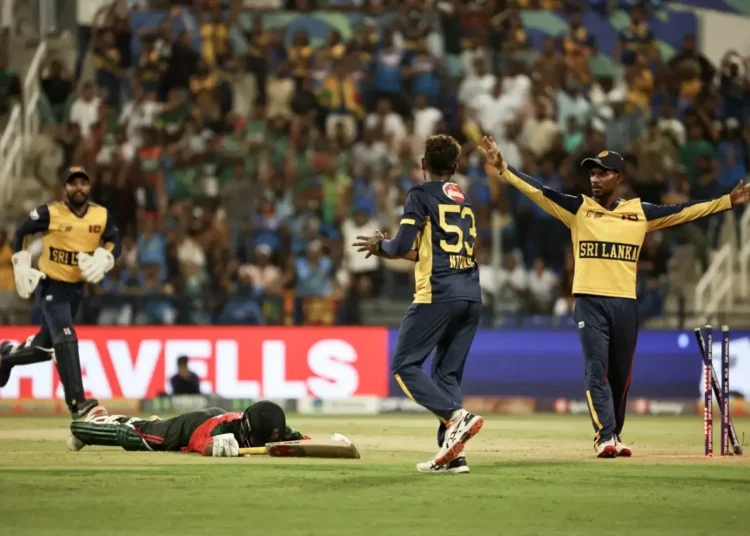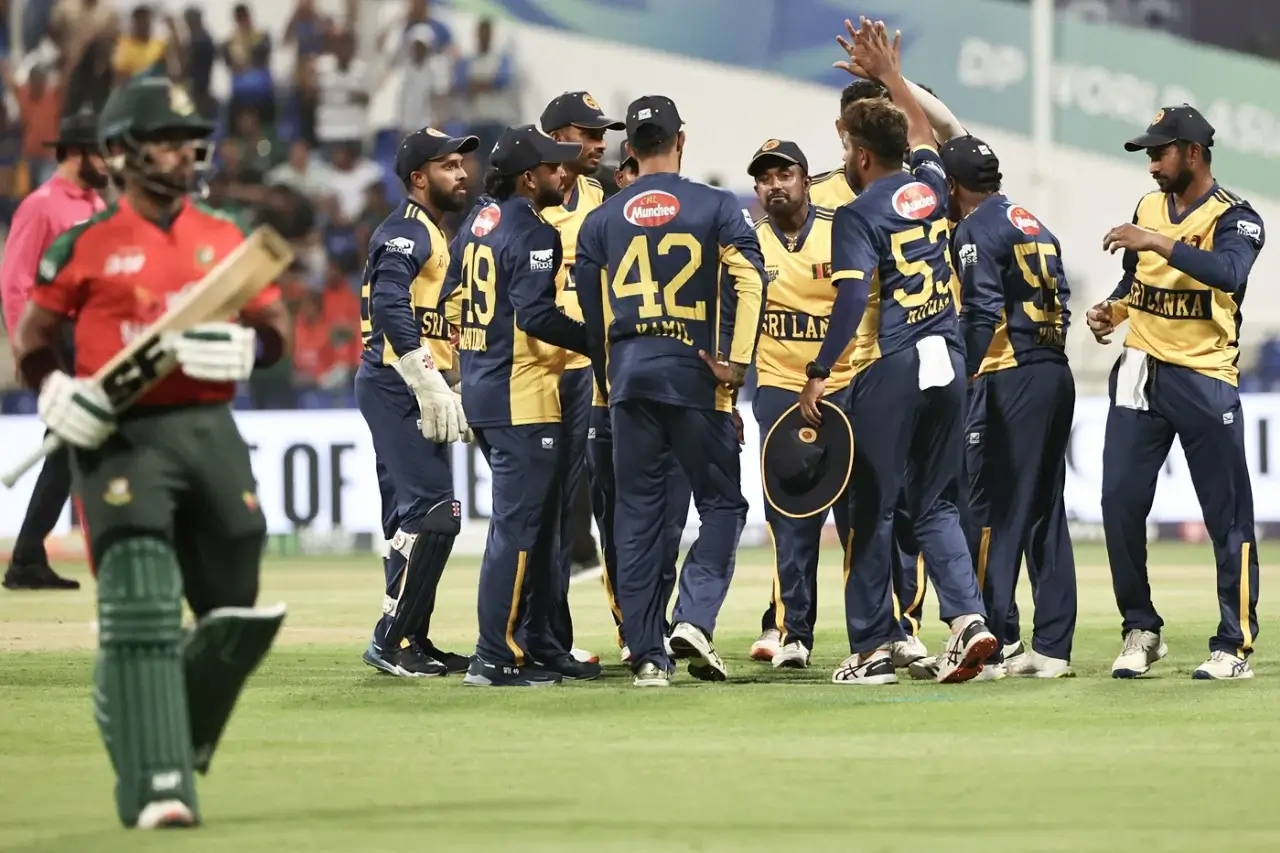Sri Lanka began their Asia Cup 2025 journey with a strong win in Abu Dhabi. They defeated Bangladesh by six wickets in a game where their fast bowlers and top order stole the show. Pathum Nissanka played a key role with a fluent half-century. Kamil Mishara gave steady support and finished unbeaten to secure the chase.
Bangladesh, on the other hand, had a nightmare start with the bat. Their top order collapsed early, leaving them struggling to recover. Two wicket-maidens by Sri Lanka’s seamers pushed them into deep trouble. The only bright spot came when Shamim Hossain and Jaker Ali added a fighting stand. That partnership gave Bangladesh some respectability, but it was never enough against Sri Lanka’s powerful chase, like the Mumbai Indians.
This game was also notable because Sri Lanka left out their mystery spinner Maheesh Theekshana. For years, mystery spin was central to Sri Lanka’s white-ball cricket. Yet here, they showed confidence in their pace battery. That bold decision worked perfectly. With seamers dominating upfront and Hasaranga providing control, Sri Lanka sealed a convincing win in just 14.4 overs.
PowerPlay Collapse Leaves Bangladesh Stunned
Bangladesh had a horror beginning in their PowerPlay overs. Nuwan Thushara and Dushmantha Chameera each bowled wicket-maidens. That pressure left Bangladesh 0 for 2 after two overs, something rarely seen in T20 cricket. Losing 20% of wickets without scoring was a huge setback.
Towhid Hridoy survived a reprieve but was run out soon after. Kamil Mishara produced a sharp, direct hit to remove him cheaply. The only resistance came from skipper Litton Das, who struck three boundaries against Dasun Shanaka. Still, Bangladesh were just 30 for 3 after six overs. That slow start created a steep uphill battle.
Sri Lanka’s pace attack had taken control early. The bowlers kept tight lines and limited boundary scoring. Thushara’s ability to swing the ball and Chameera’s pace meant batters were forced into errors. This early collapse shaped the entire game and gave Sri Lanka a cushion in the chase.
Middle-Order Fightback by Jaker Ali and Shamim Hossain
After being reduced to 54 for 5, Bangladesh were in deep trouble. Wanindu Hasaranga trapped Mahedi Hasan LBW with a googly and then dismissed Litton Das with a clever variation. At that stage, a collapse below 120 looked certain.
Jaker Ali and Shamim Hossain then turned things around. They combined for a record sixth-wicket partnership of 86 runs. Both batters rotated strike well and found timely boundaries. Shamim’s six off Matheesha Pathirana lifted the tempo. Jaker anchored the stand with smart singles and placement.
That effort took Bangladesh to 139 for 5 in 20 overs. On paper, it was a decent recovery after such a poor start. Yet against Sri Lanka’s in-form batters, the total looked at least 20 runs short. The recovery showed Bangladesh’s fighting spirit but exposed their fragile top order.
Sri Lanka’s Chase: Nissanka Leads, Mishara Finishes
Sri Lanka’s reply was confident and aggressive. They lost Kusal Mendis early to Mustafizur Rahman, but Pathum Nissanka settled nerves quickly. He smashed a six and back-to-back boundaries off Shoriful Islam. Mishara joined him and played with calm assurance.
The pair added 95 runs for the second wicket, which sealed the game. Nissanka reached his fifty in just 31 balls, bringing up 2000 T20I runs in the process. His timing and placement were perfect, finding gaps with ease. Mishara played the anchor role and kept rotating strike.
A brief wobble came when Mahedi Hasan dismissed Nissanka and Kusal Perera in quick succession. Tanzim Hasan Sakib also removed Shanaka cheaply. But by then, Sri Lanka were well ahead. Mishara’s unbeaten 46 ensured the chase ended with ease in 14.4 overs.
Why Sri Lanka’s Pace Over Spin Strategy Worked?
For decades, Sri Lanka relied on mystery spinners to dominate white-ball cricket. From Muralidaran to Ajantha Mendis, spinners were central to their plans. Against Bangladesh, however, they chose to leave out Theekshana. Instead, they backed seamers like Chameera, Thushara, and Pathirana.
This decision was bold but effective. Thushara and Chameera gave Sri Lanka the perfect start with back-to-back wicket-maidens. Their discipline made run-scoring nearly impossible in the opening overs. Pathirana was expensive at the death, but the damage was already done.
Wanindu Hasaranga, the only frontline spinner, delivered a tight spell. His two wickets broke the middle order and kept the target within reach. Sri Lanka’s selectors deserve credit for reading the conditions well. Their pace-first strategy worked in Abu Dhabi, where the pitch offered bounce and swing.
Evolution of Sri Lanka’s Bowling Strength
Sri Lanka’s current structure has helped balance their bowling resources. The National Super League has given bowlers more exposure. Selectors have managed formats carefully, keeping pacers fresh and ready.
Now, specialists exist for each format. Thushara and Pathirana focus on T20 cricket. Dilshan Madushanka plays mainly ODIs. Test roles are given to Vishwa Fernando and Lahiru Kumara. This depth allows Sri Lanka to pick bowlers based on conditions. Against Bangladesh, pace was the right call, and it worked beautifully.
Key Lessons for Both Teams
Bangladesh need to fix their top-order problems quickly. Early wickets in the PowerPlay make it hard to post winning totals. Their middle-order showed fight, but consistency is missing. Improving strike rotation and avoiding risky runs is critical.
Sri Lanka’s biggest positive is their adaptability. They can now win with seam or spin. Nissanka’s form at the top gives stability. Mishara’s confidence adds depth to the batting. The fielding sharpness, including run-outs, also showed progress.
Fans can revisit past encounters like the India vs Bangladesh cricket timeline to see how these patterns repeat. Meanwhile, Sri Lanka’s flexible approach mirrors lessons from earlier eras. Just as the first women’s ODI World Cup reshaped history, this match showed the value of evolving strategies.
Conclusion: A Convincing Start for Sri Lanka
Sri Lanka’s six-wicket win over Bangladesh was more than a group-stage result. It underlined their growing depth and ability to adapt. The decision to drop Theekshana and back their seamers proved correct. Thushara and Chameera’s early wickets created the base, while Hasaranga ensured no middle-order recovery.
For Bangladesh, this was a match of two halves. Their top order failed badly, but Jaker and Shamim showed determination. To succeed, they must find stability at the top and rotate better under pressure.
Sri Lanka, meanwhile, continue to look stronger. Their fast bowlers are improving, their batting has reliable anchors, and their strategies are evolving. If they carry this momentum forward, they will be serious contenders in this Asia Cup.
This was not just a win, but a statement. Sri Lanka proved they no longer need mystery spin alone. Their pace attack can win games in Asia. With Nissanka firing and Mishara growing in confidence, this team looks balanced and ready for bigger challenges.






